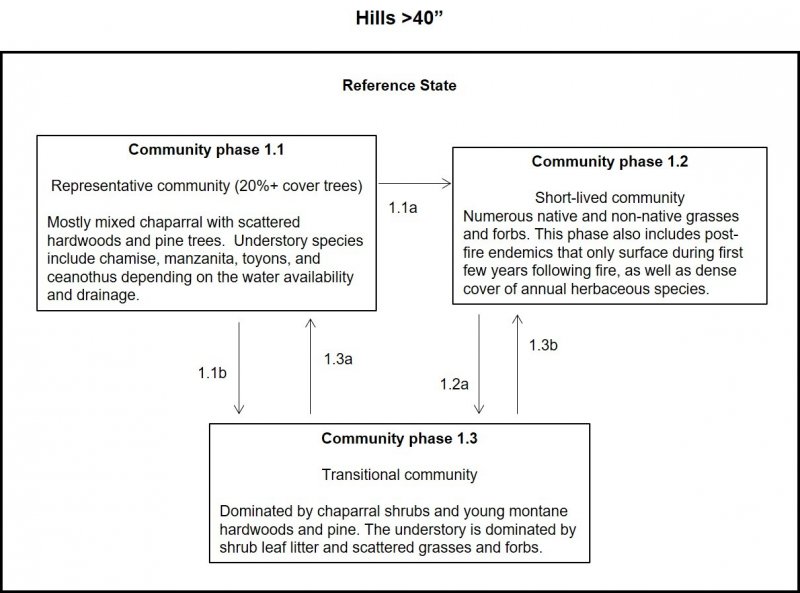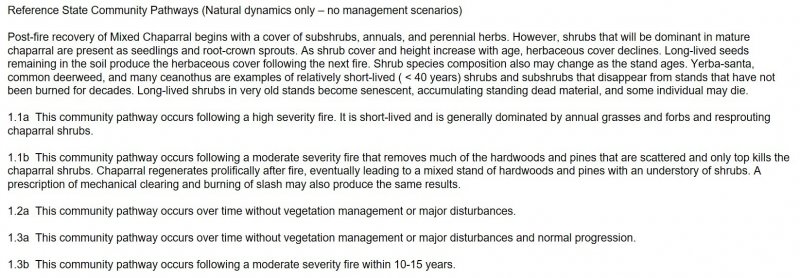Ecological site group F015XY010CAESG
Hills >40"ppt
Last updated: 09/07/2023
Accessed: 12/22/2025
Ecological site group description
Key Characteristics
- located on hills
- >40" ppt
Provisional. A provisional ecological site description has undergone quality control and quality assurance review. It contains a working state and transition model and enough information to identify the ecological site.
Physiography
This ESG is typically found on hills and upland slopes from 10 to 75 percent. Elevations typically range from 1000 to 3600 feet.
Climate
The average annual precipitation in this area is typically 40 to 88 inches (1000 to 2235 millimeters) increasing with elevation. Snowfall is common in the northern half of the part north of San Francisco and rare elsewhere. Precipitation is evenly distributed throughout fall, winter, and spring but is very low in summer. Coastal areas receive some moisture from fog in summer. Most of the rainfall occurs as low- or moderate-intensity, Pacific frontal storms during the period October to May. The average annual temperature is 52 to 65 degrees F (11 to 18 degrees C), decreasing from south to north. The freeze-free period averages 275 days and ranges from 180 to 365 days, decreasing in length with elevation and from south to north.
Soil features
Soils in this ESG consist mainly of shallow to very deep, well drained to somewhat excessively drained soils that formed in residuum weathered from shale, schist, greenstone, sandstone and conglomerate or sedimentary and metasedimentary rocks. However, the Henneke soils are shallow, well drained soils that formed in material weathered from ultramafic serpentinite rocks.
The soils that represent this ESG include:
Henneke, a loamy, mixed, superactive, mesic Lithic Ultic Haploxerolls
Hopland, a fine-loamy, mixed, active, mesic Typic Haploxeralfs
Mayacama, a loamy-skeletal, mixed, active, mesic Typic Dystroxerepts
Maymen, a loamy, mixed, active, mesic, shallow Typic Dystroxerepts
Vegetation dynamics
This ESG covers the mostly thermic (warm) areas that receive more than 40 inches of precipitation each year in MLRA 15 that are a part of a vast complex of oak woodlands, chaparral, and perennial native grasslands. The fragmented and urbanized landscape in these lower elevation hills within this MLRA that exists today makes it difficult to completely piece together the natural landscape prior to human influences.
Mixed chaparral occurs on all aspects, but at lower elevations, it generally is found on north-facing slopes. This pattern is especially true in southern California. Generally, it occurs on steep slopes and ridges with relatively thin, well-drained soils. Soils can be rocky, sandy, gravelly or clayey. The Mediterranean climate is characterized by cool, wet winters and hot, dry summers.
Mixed chaparral is a structurally homogeneous brushland type dominated by shrubs with thick, stiff, heavily cutinized evergreen leaves. Shrub height and crown cover vary considerably with age since last burn, precipitation regime, aspect, and soil type. At maturity, cismontane Mixed Chaparral typically is a dense, nearly impenetrable thicket with greater than 80 percent absolute shrub cover. Canopy height ranges from 1 to 4 m (3.3 to 13.1 fl), occasionally to 6 m (19.6 fl). On poor sites, serpentine soils or transmontane slopes, shrub cover may be only 30 to 60 percent and shrubs may be shorter, 0.5 to 3.0 m (1.6 to 9.8 fl). Considerable leaf litter and standing dead material may accumulate in stands that have not burned for several decades.
Mixed chaparral is a floristically rich type that supports approximately 240 species of woody plants. Composition changes between northern and southern California and with precipitation regime, aspect, and soil type. Dominant species in cismontane Mixed Chaparral include scrub oak, chaparral oak, and several species of ceanothus and manzanita. Individual sites may support pure stands of these shrubs or diverse mixtures of several species. Commonly associated shrubs include chamise, birchleaf mountain mahogany, silk-tassel, toyon, yerba-santa, California buckeye, poison-oak, sumac, California buckthorn, hollyleaf cherry, Montana chaparral-pea, and California fremontia. Some of these species may be locally dominant. Leather oak and interior silktassel are widely distributed on cismontane serpentine soils, and chamise and toyon may be abundant on these soils. Shrubs such as Jepson, coyote, and dwarf ceanothus and serpentine manzanita are local serpentine endemics. Incense-cedar, knobcone pine, Coulter pine, and foothill pine frequently are found in Mixed Chaparral on serpentine soils (Henneke).
Information from:
California Wildlife Habitat Relationships System
California Department of Fish and Game
California Interagency Wildlife Task Group
A. Sidney England
Major Land Resource Area
MLRA 015X
Central California Coast Range
Stage
Provisional
Contributors
Kendra Moseley
Darren Pinnegar
Click on box and path labels to scroll to the respective text.

